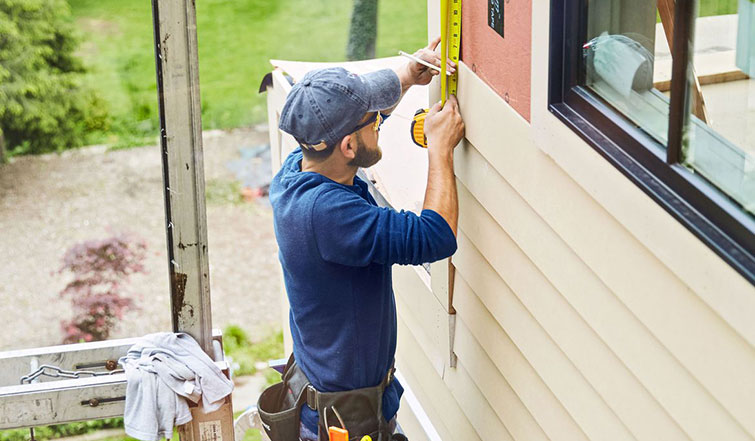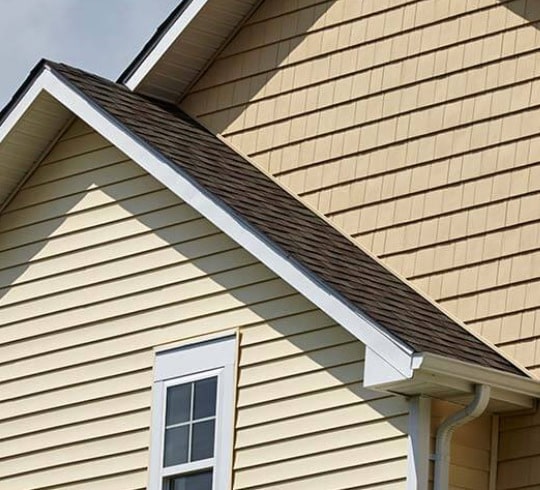Experienced Morris Siding Contractor Delivering Outstanding Curb Appeal
Wiki Article
The Vital Guide to the Numerous Sorts Of Home Siding and Their Unique Benefits
In the world of home renovation, selecting the ideal exterior siding is an important choice that impacts both aesthetic charm and functional performance. With so several options to take into consideration, which home siding material really stands out for your specific job?Timber Exterior Siding
Timber house siding, a preferred selection for domestic outsides, provides an ageless aesthetic that integrates natural charm with structural stability. This exterior siding product is readily available in various designs, including clapboard, shingles, and board-and-batten, allowing house owners to tailor their façade to match their layout preferences. Timber house siding is commonly crafted from durable varieties such as cedar, redwood, or ache, which are recognized for their resilience and capacity to stand up to ecological stressors.Among the main advantages of timber siding is its outstanding insulation homes, which can add to power effectiveness and lower heating prices. Additionally, timber exterior siding is naturally degradable, making it an environmentally friendly alternative when sourced sustainably. Regular maintenance, consisting of painting or discoloration, can extend its life-span and enhance its look, permitting property owners to maintain the natural beauty of the wood.
Nevertheless, potential disadvantages consist of sensitivity to insects, rot, and climate damage, requiring appropriate therapy and maintenance - morris siding contractor. In spite of these problems, when appropriately looked after, wood exterior siding can supply a beautiful and long lasting remedy that boosts the character of a home while offering a warm, inviting atmosphere

Vinyl Siding
Plastic house siding has actually emerged as a leading option for homeowners looking for a low-maintenance exterior alternative that integrates sturdiness and affordability. This flexible material is crafted from polyvinyl chloride (PVC), making it resistant to numerous weather, including dampness and UV rays. Therefore, plastic exterior siding does not warp, rot, or discolor, ensuring resilient aesthetic charm.Among the primary benefits of plastic siding is its substantial range of shades and designs, allowing home owners to achieve the wanted search for their home without the need for regular repainting. Additionally, vinyl home siding is very easy to install, which can substantially lower labor costs during building and construction or renovation projects.
Vinyl home siding likewise adds to power performance. Many options feature insulation backing, which boosts thermal efficiency, assisting to keep comfy interior temperature levels and possibly decreasing power costs. Additionally, its smooth surface helps with simple cleaning, needing only routine washing with a yard hose to remove dust and particles.
Fiber Cement Exterior Siding
Fiber cement siding has gained grip amongst house owners and building contractors alike because of its remarkable mix of durability and visual convenience. Made up of a mix of cellulose, concrete, and sand fibers, this siding alternative is crafted to endure extreme climate condition, including high winds, hefty rain, and temperature level changes, making it a lasting choice for domestic exteriors.
Among the primary advantages of fiber cement home siding is its resistance to insects, such as termites, and its non-combustible nature, offering boosted fire safety. morris siding contractor. In addition, it is offered in a vast range of structures, colors, and styles, permitting homeowners to achieve their preferred visual without giving up performance
One more benefit is its reduced upkeep needs; fiber cement exterior siding commonly requires painting or staining every 5-10 years, which is less regular than various other products. Its durability adds to a reduced overall expense of ownership, as it minimizes the requirement for regular fixings or substitutes.
Inevitably, fiber cement exterior siding represents an exceptional financial investment for those looking for a durable, appealing, and flexible outside alternative, incorporating both kind and feature to improve the home's visual charm.
Metal Exterior Siding
The allure of steel home siding depends on its robust toughness and contemporary aesthetic allure, making it a popular choice for contemporary style. Readily available click here for more in products such as aluminum and steel, steel house siding supplies an array of surfaces and colors, enabling property owners to achieve a customized look that enhances their style vision.
Energy efficiency is one more considerable benefit, as lots of steel house siding products are developed with insulation options that help manage interior temperature levels. This can lead to decreased power prices with time. In addition, steel house siding is usually recyclable, making it an eco pleasant option for sustainability-minded property owners.
The setup process for metal home siding can be fairly simple, resulting in a quicker turnaround time for construction tasks. Generally, metal siding incorporates functionality and design, making it a sensible choice for those seeking a aesthetically appealing and long-lasting exterior finish.
Block and Stone Siding
Block and stone siding attracts attention as a classic choice that boosts the aesthetic appeal of any kind of home. Known for their resilience and low upkeep, these materials supply a phenomenal roi while raising the residential or commercial property's visual appeal. Readily available in different shades, textures, and patterns, block and stone can be tailored to match diverse building styles, from typical to modern.One of the main benefits of brick and rock house siding is their energy effectiveness. Both products possess natural insulating homes that help control interior temperature levels, possibly reducing cooling and heating expenses. In addition, they supply superior fire resistance compared to other home siding alternatives, adding to improved safety and security.
Another benefit is their longevity. Brick and stone can last for decades, frequently needing marginal upkeep past periodic cleansing. Unlike wood home siding, they are unsusceptible parasites and rot, making certain a durable exterior that holds up against the elements.
Conclusion
In summary, the selection of exterior siding substantially influences a home's visual allure, power effectiveness, and upkeep demands. Each sort of house siding-- whether timber, plastic, fiber block, steel, or cement and stone-- provides distinct benefits customized to different house owner preferences and environmental problems. Recognizing these alternatives allows informed decisions this contact form that boost both the longevity and aesthetic charm of household exteriors. Eventually, choosing the appropriate home siding is vital for achieving an equilibrium between functionality and layout in domestic architecture.One of the primary benefits of timber siding is its exceptional insulation residential properties, which can contribute to energy performance and lower heating prices. Additionally, wood home siding is biodegradable, making it an ecologically pleasant alternative visit their website when sourced sustainably.One of the primary benefits of steel house siding is its resistance to different ecological variables.Power efficiency is one more significant benefit, as many metal home siding products are designed with insulation alternatives that aid manage interior temperature levels. Each type of home siding-- whether timber, plastic, fiber block, concrete, or steel and rock-- offers distinct benefits tailored to different house owner choices and ecological problems.
Report this wiki page